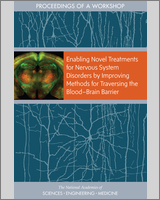NCBI Bookshelf. A service of the National Library of Medicine, National Institutes of Health.
National Academies of Sciences, Engineering, and Medicine; Health and Medicine Division; Board on Health Sciences Policy; Forum on Neuroscience and Nervous System Disorders. Enabling Novel Treatments for Nervous System Disorders by Improving Methods for Traversing the Blood–Brain Barrier: Proceedings of a Workshop. Washington (DC): National Academies Press (US); 2018 Mar 8.

Enabling Novel Treatments for Nervous System Disorders by Improving Methods for Traversing the Blood–Brain Barrier: Proceedings of a Workshop.
Show detailsDespite substantial advances in developing treatments for the serious illnesses that affect people worldwide, there remains a tremendous unmet need in the treatment of complex neurological diseases, including neuropsychiatric and neurodegenerative disorders, said Husseini Manji, global therapeutic head for neuroscience at Janssen Research & Development. Chief among the challenges that have hindered the development of therapeutics for central nervous system (CNS) disorders is the blood–brain barrier (BBB), he said.
The BBB has been historically viewed simply as a physical barrier, according to Danica Stanimirovic, director of the Translational Bioscience Department at the National Research Council of Canada. Yet we now know that it is a complex dynamic system that involves multiple cell types and transporters and interacts with other elements in its environment, she said. Stanimirovic added that exploiting this new evolving understanding of the BBB could enable the development of more intelligent drug-delivery strategies. Manji agreed, noting that new tools and technologies that would allow molecules to cross the BBB could enable treatment with a range of large molecules, including antibodies and other biologic agents (biologics).
The BBB has stymied CNS treatment development and relegated it to orphan status, said Steven Hyman, director of the Stanley Center for Psychiatric Research at the Broad Institute of Harvard and Massachusetts Institute of Technology. Manji suggested that the field is now at an inflection point and poised to move forward in developing technologies to traverse the BBB. To galvanize the scientific community to take on this challenge and bring different resources to bear, the Forum on Neuroscience and Nervous System Disorders of the Health and Medicine Division of the National Academies of Sciences, Engineering, and Medicine convened a workshop on September 8, 2017. The workshop planning committee was tasked with bringing together experts from academia, government, the biotechnology and pharmaceutical industries, disease-focused organizations, nonprofit foundations, and other interested stakeholders to explore current and evolving strategies for traversing the BBB to deliver therapeutics to the CNS (see Box 1-1). Workshop participants also discussed gaps to address, including potential regulatory obstacles, and explored strategies for accelerating research and clinical translation through the establishment of consortia and public–private partnerships (PPPs). This workshop explored mechanisms that are relevant across conditions, but it did not delve deeply into any specific condition.
BOX 1-1
Statement of Task.
The committee will develop the agenda for the workshop, select and invite speakers and discussants, and moderate the discussions. A summary of the presentations and discussions at the workshop will be prepared by a designated rapporteur in accordance with institutional guidelines.
WORKSHOP OBJECTIVES
The workshop was designed to explore the challenges associated with the BBB that have thus far stymied development of CNS drugs, examine new technologies that could address these challenges, and highlight potential opportunities for moving the field forward.
ORGANIZATION OF THE PROCEEDINGS
The following proceedings summarize the workshop presentations and discussions. Chapter 2 briefly summarizes the structure and function of the BBB, diseases related to its breakdown, challenges that arise in designing therapeutics that will cross or bypass the BBB, and opportunities to address these challenges. Chapter 3 surveys the modalities and technologies currently in development for traversing the BBB to deliver therapeutic molecules to the CNS, as well as models being used to facilitate the discovery and development of new drugs to treat CNS diseases. Chapter 4 explores regulatory issues and concerns for investigators to consider as they move through preclinical and clinical phases of development.
Chapter 5 examines innovative funding models and partnership strategies to accelerate research and facilitate clinical translation of these technologies by increasing collaboration and establishing PPPs across various stakeholder communities, including academia, industry, the private sector, and federal agencies.
Footnotes
- 1
The planning committee's role was limited to planning the workshop, and this Proceedings of a Workshop was prepared by the workshop rapporteurs as a factual summary of what occurred at the workshop. Statements, recommendations, and opinions expressed are those of individual presenters and participants, and have not been endorsed or verified by the Health and Medicine Division (HMD) of the National Academies of Sciences, Engineering, and Medicine, and they should not be construed as reflecting any group consensus.
- Introduction and Overview - Enabling Novel Treatments for Nervous System Disorde...Introduction and Overview - Enabling Novel Treatments for Nervous System Disorders by Improving Methods for Traversing the Blood–Brain Barrier
Your browsing activity is empty.
Activity recording is turned off.
See more...